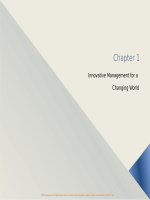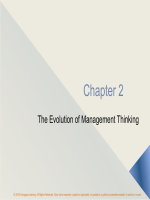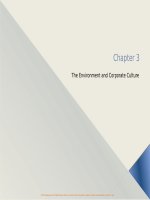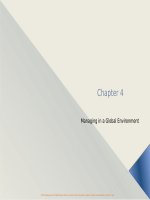Management 12e by w griffin ch14
Bạn đang xem bản rút gọn của tài liệu. Xem và tải ngay bản đầy đủ của tài liệu tại đây (671.65 KB, 33 trang )
TWELFTH EDITION
MANAGEMENT
Ricky W. Griffin
Part Five: The Leading Process
Chapter Fourteen: Basic Elements of Individual Behavior in Organizations
© 2017 Cengage Learning. All rights reserved. May not be copied, scanned, or duplicated, in whole or in part, except for use as permitted in a license distributed with a certain product or service or otherwise on a password-protected
website for classroom use.
14 - 1
Learning Outcomes
1.
2.
3.
4.
5.
6.
7.
Explain the nature of the individual – organization relationship.
Define personality and describe personality attributes that affect behavior in
organizations.
Discuss individual attitudes in organizations and how they affect behavior.
Describe basic perceptual processes and the role of attributions in organizations.
Discuss the causes and consequences of stress and describe how it can be
managed.
Describe creativity and its role in organizations.
Explain how workplace behaviors can directly or indirectly influence organizational
effectiveness.
© 2017 Cengage Learning. All rights reserved. May not be copied, scanned, or duplicated, in whole or in part, except for use as permitted in a license distributed with a certain product or service or otherwise on a password-protected
website for classroom use.
14 - 2
Understanding Individuals in Organizations
Psychological contract
– is the overall set of expectations held by an individual with respect to their
contributions to the organization and what the organization will provide in
return.
– The individual provides contributions such as effort, skill, ability, time, or
loyalty.
– The organization provides inducements both tangible (pay) and intangible
(status).
© 2017 Cengage Learning. All rights reserved. May not be copied, scanned, or duplicated, in whole or in part, except for use as permitted in a license distributed with a certain product or service or otherwise on a password-protected
website for classroom use.
14 - 3
Figure 14.1
The Psychological Contract
The psychological contract is not written on paper nor are the terms
negotiated.
© 2017 Cengage Learning. All rights reserved. May not be copied, scanned, or duplicated, in whole or in part, except for use as permitted in a license distributed with a certain product or service or otherwise on a password-protected
website for classroom use.
14 - 4
Understanding Individuals in Organizations
Person-job fit
– is the extent to which the individual contributions match the organizational
inducements.
– Possible reasons for imperfect person-job fit:
•
•
•
Organizational selection procedures are imperfect.
Both people and organizations change.
Each individual is unique.
Individual differences
– are personal attributes that vary from one person to another.
© 2017 Cengage Learning. All rights reserved. May not be copied, scanned, or duplicated, in whole or in part, except for use as permitted in a license distributed with a certain product or service or otherwise on a password-protected
website for classroom use.
14 - 5
Personality and Individual Behavior
Personality
The relatively permanent
set of psychological and behavioral
attributes that distinguish one person from another.
Managers should strive to understand basic personality attributes.
© 2017 Cengage Learning. All rights reserved. May not be copied, scanned, or duplicated, in whole or in part, except for use as permitted in a license distributed with a certain product or service or otherwise on a password-protected
website for classroom use.
14 - 6
“Big Five” Personality Traits
Agreeableness
•
A person’s ability to get along with others.
Conscientiousness
•
The number of things a person can effectively work on at one time.
Negative emotionality
•
Extent to which a person is poised, calm, resilient, and secure.
Extraversion
•
A person’s comfort level with relationships.
Openness
•
A person’s rigidity of beliefs and range of interests.
© 2017 Cengage Learning. All rights reserved. May not be copied, scanned, or duplicated, in whole or in part, except for use as permitted in a license distributed with a certain product or service or otherwise on a password-protected
website for classroom use.
14 - 7
Figure 14.2
The “Big Five” Model of Personality
© 2017 Cengage Learning. All rights reserved. May not be copied, scanned, or duplicated, in whole or in part, except for use as permitted in a license distributed with a certain product or service or otherwise on a password-protected
website for classroom use.
14 - 8
The Myers-Briggs Framework
Extraversion (E) versus Introversion (I)
– Extraverts gather energy from others, introverts need solitude to recharge their
energy.
Sensing (S) versus Intuition (N)
Thinking (T) versus Feeling (F)
Judging (J) versus Perceiving (P)
– Sensing types prefer concrete ideas, intuitive types prefer abstract concepts.
– Thinkers base decisions on logic, feelers on emotion.
– Judgers prefer completion, perceivers enjoy the process.
© 2017 Cengage Learning. All rights reserved. May not be copied, scanned, or duplicated, in whole or in part, except for use as permitted in a license distributed with a certain product or service or otherwise on a password-protected
website for classroom use.
14 - 9
Other Personality Traits at Work
Locus of control
– is the degree an individual believes their behavior directly impacts the
consequences of that behavior.
•
•
Internal locus of control is a belief that success/failure results from one’s own behavior.
External locus of control is a belief that success/failure results from fate, chance, luck, or
the behavior of others.
Self-efficacy
– is an individual’s beliefs about her or his capabilities to perform a task.
© 2017 Cengage Learning. All rights reserved. May not be copied, scanned, or duplicated, in whole or in part, except for use as permitted in a license distributed with a certain product or service or otherwise on a password-protected
website for classroom use.
14 - 10
Other Personality Traits at Work
Authoritarianism
– is an individual’s belief that power and status differences are appropriate in an
organization.
Machiavellianism
Self-esteem
– is behavior directed at gaining power and controlling behavior of others.
– is the extent to which a person believes they are worthwhile and a deserving
individual.
Risk propensity
– is the degree to which an individual is willing to take chances and make risky
decisions.
© 2017 Cengage Learning. All rights reserved. May not be copied, scanned, or duplicated, in whole or in part, except for use as permitted in a license distributed with a certain product or service or otherwise on a password-protected
website for classroom use.
14 - 11
Emotional Intelligence
Emotional intelligence or EQ
– is the extent to which people are self-aware, manage their emotions, motive
themselves, express empathy, and possess social skills.
– Research suggest persons with high EQ may perform better than others.
– EQ appears to be something not biologically based, it can be developed within
a person.
© 2017 Cengage Learning. All rights reserved. May not be copied, scanned, or duplicated, in whole or in part, except for use as permitted in a license distributed with a certain product or service or otherwise on a password-protected
website for classroom use.
14 - 12
Emotional Intelligence
Managing
Self-awareness
Motivating oneself
emotions
Empathy
Social skills
There are five dimensions of EQ.
© 2017 Cengage Learning. All rights reserved. May not be copied, scanned, or duplicated, in whole or in part, except for use as permitted in a license distributed with a certain product or service or otherwise on a password-protected
website for classroom use.
14 - 13
Attitudes and Individual Behavior
Attitudes
– are complexes of beliefs/feelings people have about specific ideas, situations, or
other people.
•
•
The affective component reflects feelings and emotions an individual has toward a situation.
•
The intentional component reflects how an individual expects to behave toward or in the
situation.
The cognitive component derives from perceived knowledge an individual has about a
situation.
– Cognitive dissonance occurs when an individual has conflicting attitudes.
© 2017 Cengage Learning. All rights reserved. May not be copied, scanned, or duplicated, in whole or in part, except for use as permitted in a license distributed with a certain product or service or otherwise on a password-protected
website for classroom use.
14 - 14
Work-Related Attitudes
Job satisfaction or dissatisfaction
Organizational commitment
Organizational engagement
– reflects the extent an individual is gratified by or fulfilled by their work.
– reflects an individual’s identification with and attachment to the organization.
– is the extent an employee sees themselves as part of the organization, actively
looks for ways to contribute, and is involved in multiple ways.
© 2017 Cengage Learning. All rights reserved. May not be copied, scanned, or duplicated, in whole or in part, except for use as permitted in a license distributed with a certain product or service or otherwise on a password-protected
website for classroom use.
14 - 15
Affect and Mood in Organizations
Positive affectivity
– is a tendency to be upbeat and optimistic, have an overall sense of well-being,
see things in a positive light, and seem to be in a good mood.
Negative affectivity
– is a tendency to be generally downbeat and pessimistic, see things in a
negative way, and seem to be in a bad mood.
© 2017 Cengage Learning. All rights reserved. May not be copied, scanned, or duplicated, in whole or in part, except for use as permitted in a license distributed with a certain product or service or otherwise on a password-protected
website for classroom use.
14 - 16
Perception and Individual Behavior
Perception
Is the set of processes by which an
individual becomes aware of and
interprets information about the
environment.
Because perception plays a role in a variety of other workplace behaviors, managers need
to have a general understanding of basic perceptual processes.
© 2017 Cengage Learning. All rights reserved. May not be copied, scanned, or duplicated, in whole or in part, except for use as permitted in a license distributed with a certain product or service or otherwise on a password-protected
website for classroom use.
14 - 17
Basic Perceptual Processes
Selective perception
– is the process of screening out information we are uncomfortable with or that
contradicts our beliefs.
– Helpful only if our basic perception is accurate.
Stereotyping
– is the process of categorizing or labeling people on the basis of a single attribute.
– Common attributes include race, gender, and age.
© 2017 Cengage Learning. All rights reserved. May not be copied, scanned, or duplicated, in whole or in part, except for use as permitted in a license distributed with a certain product or service or otherwise on a password-protected
website for classroom use.
14 - 18
Figure 14.3
Perceptual Processes
Two of the most basic perceptual processes are selective perception
and stereotyping.
© 2017 Cengage Learning. All rights reserved. May not be copied, scanned, or duplicated, in whole or in part, except for use as permitted in a license distributed with a certain product or service or otherwise on a password-protected
website for classroom use.
14 - 19
Perception and Attribution
Attribution
– is a mechanism through which we observe behavior and attribute causes to it.
– May be our own behavior, or that of others.
– Occurs through three forces:
•
•
•
Consensus is the extent other people in the same situation behave the same way.
Consistency is the extent the same person behaves in the same way at different times.
Distinctiveness is the extent the same person behaves in the same way in other
situations.
© 2017 Cengage Learning. All rights reserved. May not be copied, scanned, or duplicated, in whole or in part, except for use as permitted in a license distributed with a certain product or service or otherwise on a password-protected
website for classroom use.
14 - 20
Stress and Individual Behavior
Stress
– is an individual’s response to a strong stimulus, called a stressor.
General Adaptation Syndrome (GAS)
– is a general cycle of the stress process.
•
•
•
Stage 1 – alarm.
Stage 2 – resistance.
Stage 3 – exhaustion.
© 2017 Cengage Learning. All rights reserved. May not be copied, scanned, or duplicated, in whole or in part, except for use as permitted in a license distributed with a certain product or service or otherwise on a password-protected
website for classroom use.
14 - 21
Figure 14.4
The General Adaptation Syndrome
Stress is not all bad. The absence of stress may lead to stagnation.
© 2017 Cengage Learning. All rights reserved. May not be copied, scanned, or duplicated, in whole or in part, except for use as permitted in a license distributed with a certain product or service or otherwise on a password-protected
website for classroom use.
14 - 22
Stress and Individual Behavior
Type A
Type B
•
•
Individuals are competitive, devoted
Individuals are less competitive,
to work, and have a strong sense of
less devoted to work, and have a
time urgency.
weaker sense of time urgency.
Type B people are less likely to experience stress.
© 2017 Cengage Learning. All rights reserved. May not be copied, scanned, or duplicated, in whole or in part, except for use as permitted in a license distributed with a certain product or service or otherwise on a password-protected
website for classroom use.
14 - 23
Causes and Consequences of Stress
Four categories of work-related stressors
– Task demands are associated with the task itself.
– Physical demands are stressors associated with the job setting.
– Role demands are stressors associated with roles within the organization.
– Interpersonal demands are associated with relationships that confront people.
© 2017 Cengage Learning. All rights reserved. May not be copied, scanned, or duplicated, in whole or in part, except for use as permitted in a license distributed with a certain product or service or otherwise on a password-protected
website for classroom use.
14 - 24
Figure 14.5
Causes of Work Stress
© 2017 Cengage Learning. All rights reserved. May not be copied, scanned, or duplicated, in whole or in part, except for use as permitted in a license distributed with a certain product or service or otherwise on a password-protected
website for classroom use.
14 - 25









